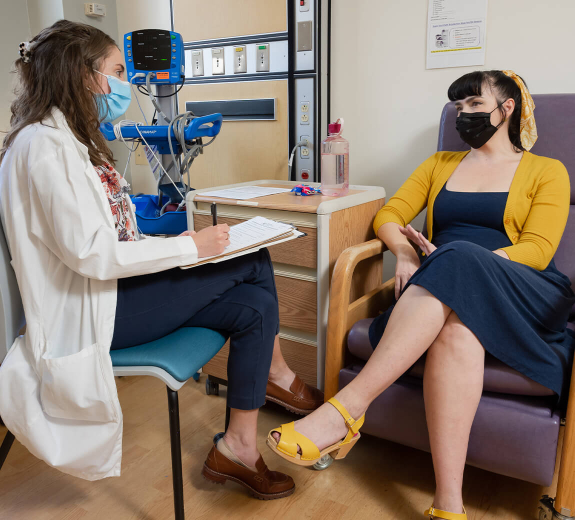“Scientists tried injecting patients with IL-10 and it didn’t do anything,” Dr. Lord says. “They tried using bacteria that make IL-10, but that didn’t do anything either.”
Years after these attempts from other scientists, Dr. Lord and his team stumbled upon this protein again when studying an unusual immune response in some people with Crohn’s disease. Their findings could shed light on how IBD happens and when IL-10 needs to present to prevent the inflammation of Crohn’s disease.
“You can’t use IL-10 as a crude sledgehammer to knock down the immune system,” Dr. Lord says. “But if it’s given at exactly the right time, by exactly the right cell, responding to exactly the right antigen, it can prevent gut inflammation that contributes to IBD.”
Finding the Perfect Context
The investigation started when researchers ran into a mystery: In some people with Crohn’s disease, the immune system reacts to E. coli, a common gut bacteria, by making antibodies to one of its proteins called OmpC.
“Everybody’s colon is full of E. coli,” Dr. Lord says. “So, you shouldn’t have a colon immune response to OmpC, but at least half of people with Crohn’s disease do.”
To find out why, researchers compared blood cells from people with Crohn’s disease to blood cells from people who were genetically similar but didn’t have Crohn’s disease.
They found that people without Crohn’s disease had T-cells that could recognize OmpC as foreign but these people didn’t make antibodies to the protein. Instead, their T-cells made a lot of IL-10, a protein known to decrease immune reactions.
Meanwhile, T-cells from people with Crohn’s disease made little to no IL-10. They also had antibodies to OmpC — a telltale sign that the immune system had attacked.
This led the research team to suspect that IL-10 needs to be made by the right immune cells at the right time and place to successfully prevent inappropriate gut inflammation.
“Determining why these immune cells don’t make IL-10 when they encounter normal gut bacteria, like E. coli, could explain how IBD happens and inform how and when IL-10 needs to be present to prevent the inflammation of Crohn’s disease,” Dr. Lord says.
Chain Reaction Causes Disease
Next, the research team plans to study the gene that makes IL-10 in extreme detail, to learn why it doesn’t work properly in some people with Crohn’s disease. They’ll look for differences in tiny molecules, which could provide insight into the chain reaction that causes the disease. If they can understand how that reaction starts, they may be able to stop it — and prevent the disease.
This approach is called a reductionist model, which means looking at the smallest parts of something to understand the whole.
“We’re looking at one peptide from one protein from one class of bacteria in one fairly common but still genetically distinct subset of Crohn’s patients,” Dr. Lord says. “It’s extremely reductionist, but that’s how science happens. If we find differences in these very specific cells, that may be true for all cells in Crohn’s. We’re trying to leapfrog from a reductionist model back to something broadly generalizable.”
These findings could go beyond Crohn’s disease and launch more questions: Does this chain reaction also keep IL-10 from stopping inflammation in ulcerative colitis and celiac disease? Is it part of the mechanism behind all autoimmune diseases?
“One of BRI’s mottos is that a breakthrough in one autoimmune disease can lead to a breakthrough in them all,” Dr. Lord says. “We typically find the same mechanisms work across the body, regardless of organ system. And I think we’re one of the only institutions on Earth that is so equipped to study multiple autoimmune diseases in parallel at such depth.”





